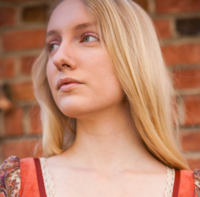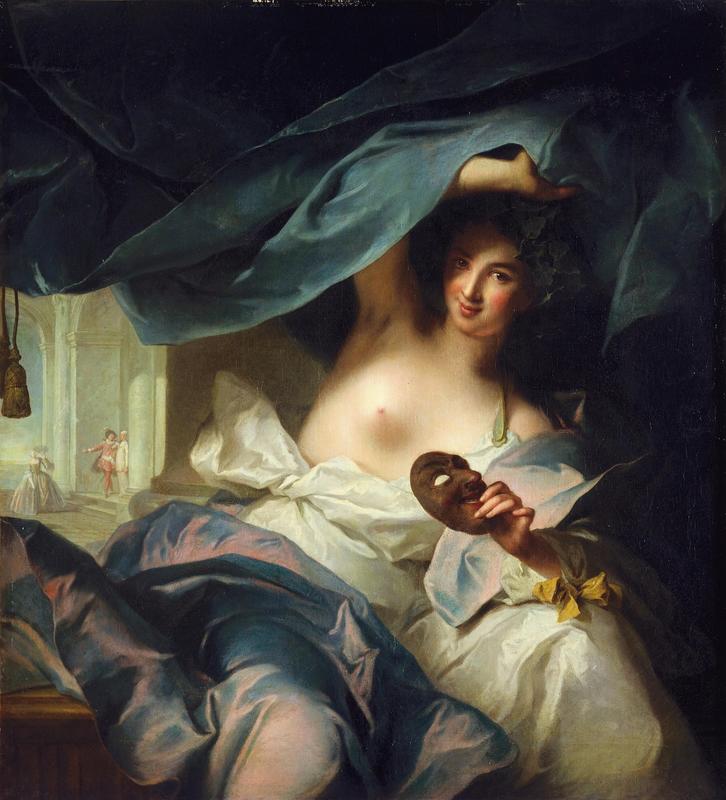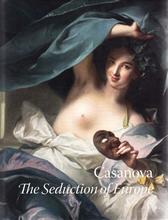More about Thalia, Muse of Comedy
- All
- Info
- Shop

Editor
18th Century Celebrity Nip-Slip takes Center Stage in Nattier’s Thalia, Muse of Comedy.
Nattier actually aspired to be a history painter, but since he needed money to exist (a sorry state of affairs that continues to plague society to this day), he turned to allegorical portraits, depicting court ladies as classical mythological figures, as a way to both make ends meet and satisfy his own artistic yearnings. In fact, Nattier is often credited with the revival of the Allegorical Portrait, a type taken up with enthusiasm by the likes of Francois Boucher, Sir Joshua Reynolds, and Angelica Kauffman. In a society that delighted in itself as thoroughly as mid-18th century France, portraiture was extremely sought after, and fashionable ladies found they really, really liked being depicted as goddesses. Who could guess? Do you hear the swish of the guillotine yet? It’s coming. Just give it a few decades.
The model for this painting is thought to be Sylvia Balletti, an actress of the Comédie-Italienne in Paris. She was supremely talented, acting with an empathy and grace that won her fame and respect from aristocrats and the general public alike. When she went out, people called out the names of her beloved characters. She even hobnobbed with members of the court of Louis XV and personalities such as Casanova, who may have loved her (and definitely was briefly in love with her daughter, Manon).
What is most astonishing is the degree of respectability she attained. In an age when actresses were considered little better than prostitutes (because if you bare your soul on stage, logically you must be cool with baring the rest of yourself off stage), Sylvia remained faithful to one man, was extremely pious, and kept a large, personal library of moral literature. And she still managed to be fun at parties. Go figure.
Here she is depicted as the Muse of Comedy herself, Thalia, bearing the traditional attributes of a crown of ivy and a comedy mask. As Thalia presided over and inspired comedy and verse, it’s fitting that an accomplished A-lister actress, one who had inspired playwrights such as Pierre Marivaux to write characters just for her, should be the model. Drawing back the sumptuous curtains, she invites us in with a mischievous smile to gaze at a commedia scene unfolding behind her as if on a stage. In fact, the Comédie-Italienne where she worked had images of Thalia on its curtains, invoking with every performance the muse she here embodies. The theatrical theme plays on continuing Venetian influences of masquerade and commedia culture in France, but also the extent to which Europe itself was captivated by theater and performance, reveling in questions of artifice and identity both on the stage and off.
Likely never intended for its sitter, this allegorical portrait was possibly commissioned instead as one of six “history” paintings for the Chevalier d’Orleans, grand prior of the order of St. John of Jerusalem. All six were images of attractive female allegorical figures, which can be edifying and gratifying in multiple ways. Indeed, it would be hard not to notice Thalia's semi-nudity here. Not only is her exposed chest in the exact center of the painting, but it appears to be basking in the spotlight!
Indeed, just as Thalia pulls back the curtain to unveil a scene behind her, so too does her extravagant drapery fall about her to reveal the tantalizing secrets of her own flesh. Playful and seductive, her exposure hearkens to the classical portrayal of goddesses, unrestrained by human mores, as well as a distinct strain of hedonism and sexual freedom pervasive in France during the Age of Reason. Seduction and pleasure--in the flesh, in sumptuous clothing, in lavish paintings, and in dazzling wit--defined the voyeuristic milieu in which Nattier worked, and this painting exemplifies that to the max.
Sources
- Bazin, Germain. Baroque and Rococo. London: Thames & Hudson, 1964.
- Johnson, James H. “The Theatre of Identity” in Casanova: The Seduction of Europe. Edited by Frederick Ilchman, Thomas Michie, C. D. Dickerson III, and Esther Bell. Boston: Museum of Fine Arts Publications, 2017.
- Kelly, Ian. Casanova: Actor, Lover, Priest, Spy. New York: Jeremy P. Tarcher/Penguin, 2008.
- Summers, Judith. Casanova’s Women: The Great Seducer and the Women he Loved. London: Bloomsbury Publishing, 2011.
- “Jean-Marc Nattier.” J. Paul Getty Museum. Accessed March 14, 2018. http://www.getty.edu/art/collection/artists/455/jean-marc-nattier-frenc…
- “Jean-Marc Nattier.” National Gallery of Art. Accessed March 14, 2018. https://www.nga.gov/collection/artist-info.1746.html












